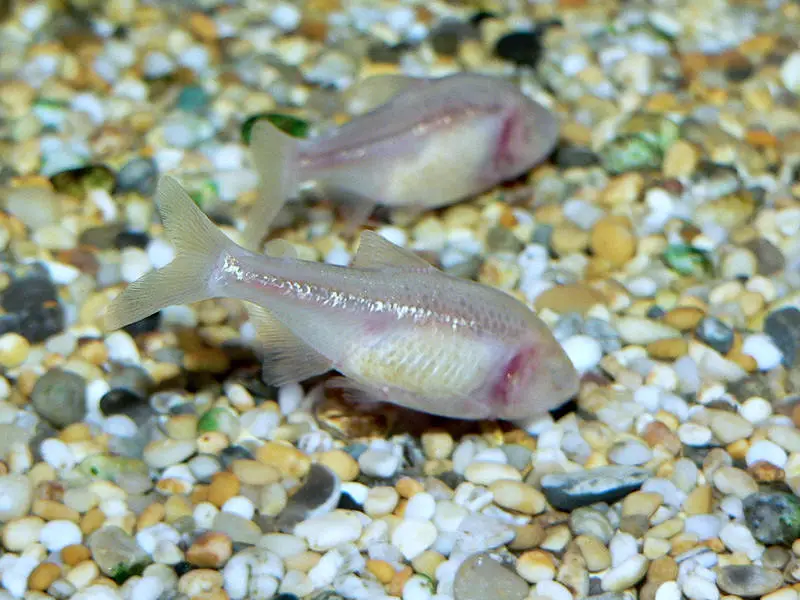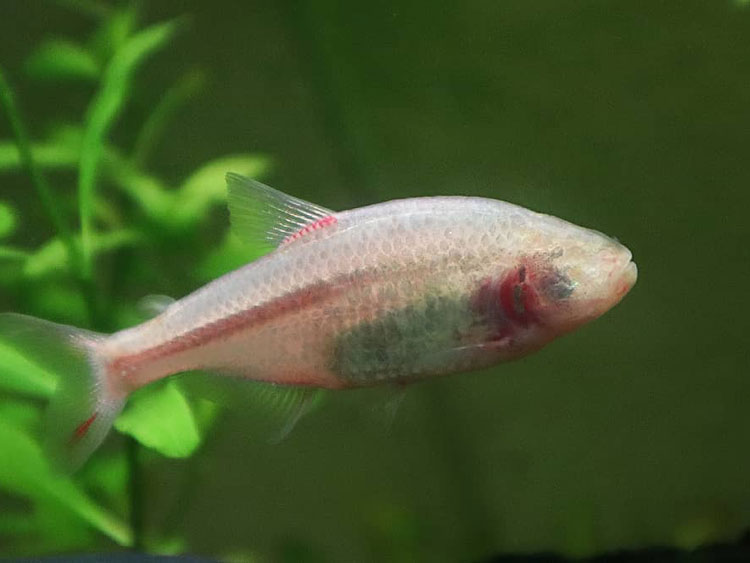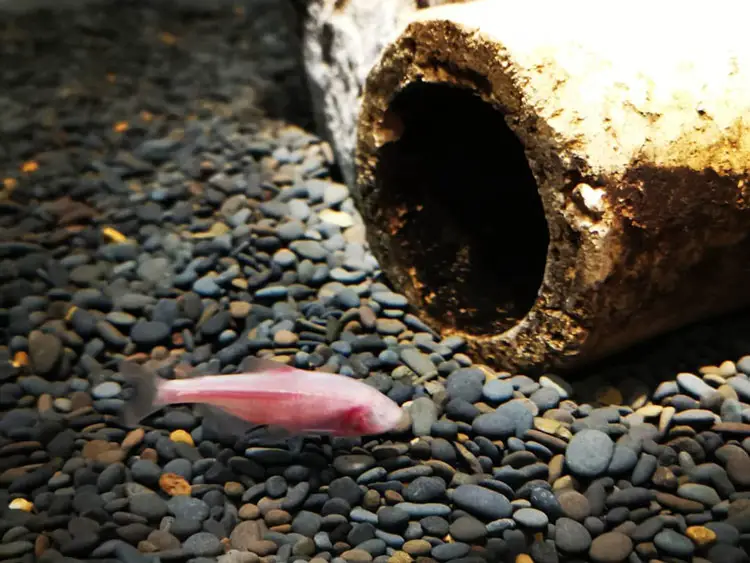The longer we keep fish, the more likely we are to become more curious about unusual species; a few of us have been attracted by these creatures from the get-go.
However, a major reason that beginners struggle with when it comes to caring for these oddball aquarium animals is that they often need specialized and complicated care requirements, such as freshwater lionfish, freshwater dolphin fish, freshwater pipefish, or freshwater stingrays.
Luckily, here is a dazzling puzzle to your strange and wonderful fish-keeping dreams: the blind cave fish (Astyanax jordani)!
Unlike other weird fish species, blind cave fish are easy to care for because they don’t need much in the way of specialized conditions. In fact, they’re pretty darn hardy and peaceful!
The following blind cave fish species profile and care will reveal their mysterious lifestyle and how you can successfully keep them in your home aquarium.
Without further ado, let’s get started!
Species Overview

The blind cave fish is a member of the Astyanax genus, which is the most diverse group of tetras. The name Astyanax comes from Hector’s son in Greek mythology [1]. However, many freshwater aquarists are unfamiliar with this eyeless and colorless fish.
Like many other tetras, this cave-dwelling fish is native to Mexico. It is also known as the Cave Tetra or its local Spanish name Tetra Ciego.
Unfortunately, the taxonomy and nomenclature of this species are in dispute [2]. Some classify it as a separate species, A. jordani, while others believe it to be a variant form of Mexican tetra (Astyanax mexicanus). This belief is supported by several lines of genetic evidence [3].
In the latter account, the eyed form is surface-dwelling fish that favor moving waters, while the blind cave form has evolved to inhabit caves.
For the sake of clarity, in this article, we will refer to this fish as A. jordani.
The fish was named in honor of C. Basil Jordan from Texas, USA, who discovered this species in a cave in San Louis Potosi, Mexico [4].
| Scientific Name: | Astyanax jordani (in dispute) |
| Common Name: | Blind Cave Fish, Cave Tetra, Tetra Ciego (Spanish) |
| Care Level: | Beginner |
| Origin: | North America and Mexico |
| Lifespan: | up to 15 years |
| Max Size: | 3.5 inches (9 cm) |
| Tank Level: | All levels |
| Social: | Peaceful shoaling species, suitable for community tanks |
| Temperature: | 68 – 77°F (20 – 25°C) |
| PH: | 6 – 7.8 |
| Water hardness: | 4 – 30 dKH |
| Diet: | Omnivorous |
| Minimum Tank Size: | 20 gallons |
Colorless & Eyeless

The most remarkable physical characteristics of blind cavefish are that they’re both blind and colorless.
Interestingly, the eyes of blind cavefish embryos are initially fully developed [5], but they degenerate and become vestigial structures within a few weeks of life because of a gene mutation. Eventually, they are covered with scales and look like dark spots in the head.
Generally, loss of coloration is a result of the complete lack of pigmentation. Previous studies have shown that the colorless appearance of blind cave fish could be incidental to evolution. However, new genetic research reveals that this may help these fish generate the energy they need [6].
So, how do these blind fish sense their surroundings, find food and avoid predators in the dark?
To compensate for the regressive evolution of the light sensitivity (lack of sight in short), they develop a specialized sensory organ called flow-sensitive lateral line receptors that run under the skin along each side, which are about twice [7] as sensitive as the eyed A. mexicanus.
Another compensatory improvement is the development of their taste buds [8], which allows them to store fat more efficiently and cope with food shortages.
Their cream or light pink bodies are covered with a layer of cephalocaudal glittery scales to protect the body and reduce water friction and resistance. You will also notice a small adipose fin between the tail and the dorsal fin.
Blind Cave Tetra Size
The standard length of an adult blind cave fish is about 3.5 inches (9 cm). Some might get slightly bigger – reaching 4 inches (10 cm).
Lifespan
Sadly, many sources are giving false information about the lifespan of blind cavefish. They claim that they have a lifespan of 3 to 5 years.
It actually has decently long life expectancies in captivity, living up to 15 years with proper care. [9] There is no reliable information on the potential lifespan of this species in the wild.
Blind Cave Fish Care
Believe it or not, these peculiar fish are a breeze to care for. While it’s true they are adapted to live in warm dark caves, they will still do well in a standard aquarium setup.
Blind Cave Fish Aquarium Size
Thanks to their small adult lengths, you don’t need a large tank to house a school of these fish. A 20-gallon aquarium is recommended for a group of half-dozen blind cave tetras.
Water Conditions
When caring for blind cave fish, the best way is to recreate their natural habitat as much as possible. This includes replicating water conditions; although these fish are hardy, staying within the accepted parameters is crucial for their health and well-being.
- Water Temperature: 68 – 77°F (20 – 25°C)
- pH: 6 – 7.8
- dGH: 4 – 30 dKH
- Ammonia: 0 ppm
- Nitrite: 0 ppm
- Nitrate: <30 ppm
Decor, Substrate & Lighting

Similarly, you might want to create a cave-style aquascape without plants for your blind cave fish, where they feel at home. For example, these underwater galleries’ cichlid stone caves can provide a great naturalistic look to your aquarium.
[amazon box=”B00A8G41BK”]A dark substrate is well suited to this species since they are used to living in complete darkness. To create a low-light habitat, using black background on three sides of the fish tank would be helpful.
Subdued lighting is preferred but not a necessity. Like Malawi aquariums, blue lights boast a dramatic effect on their pale body so that you can enjoy a shimmer of sparkling color.
Food & Diet
In nature, Astyanax jordani mostly eat insects and larvae that drift into caves.
In captivity, they are omnivorous and readily accept all food. Fine store-sought fish flakes, pellets, and small live or frozen food such as brine shrimp, bloodworms, or artemia are all good food options.
In addition, you don’t have to be concerned about feeding them in a community aquarium because they can manage to get food like other eyed fish.
Tankmates
In their natural environment, this fish is a shoaling species that is often found in large groups. In home aquariums, it is not essential to keep them in a group; they seem just as comfortable living in pairs or even singly with other species.
Like other tetra species, they may sometimes nibble on the fins of tank mates during feedings when seeking food.
Here are some blind cave fish-compatible tank mates to consider:
- Other small tetra species
- Livebearers like guppies or mollies
- Rasboras
- Dwarf gouramis
- Dwarf Corys
Avoid putting them with Oscars, Jack Dempseys, Redheads, and other large Central American cichlids that will eat blind cave tetras at the first opportunity.
Gender Differences
It can be tough to tell the difference between a female and male blind cavefish. Generally, the female tends to be larger than the male because of her more rounded abdominal area.
Breeding
Blind cavefish is one of the easier tetras to breed in home aquariums. A paired male and female will spawn naturally without any special effort on your part; however, if you want to raise their offspring, you will need a separate tank.
To induce spawning, lower the temperature to 66˚F by doing two large water changes (50% – 70%) with cooler water of the same chemistry over a week.
It is a prolific species – a female can lay up to 1000 eggs at a time and scatter them around the tank. These eggs are white and initially may appear infertile, but most will hatch.
Parent fish must be removed from the breeding tank immediately after spawning – if not, they will eat their eggs.
The eggs will hatch after 24 hours, and the fry (newborn fish) need 5-7 more days to develop before swimming on their own and consuming the yolk sac.
After your fry become free swimmers, you can feed them a commercial liquid fry food for the initial few days. Then, provide them with newly hatched baby brine shrimps and finely powdered flake food.
Closing Thoughts
The blind cave fish (Astyanax jordani) is one of a few incredibly weird fish species that aquarists of all experience levels can enjoy.
As long as you can provide them with the conditions they need, plus a little bit of love, we think these fascinating little fish are a good fit for just about everyone.
Do you have more questions that weren’t answered here? Feel free to ask us in the comments below; we’re more than happy to lend a hand.
Article Sources:
- Astyanax jordani (Fishbase.se)
- Astyanax jordani (Cavefishes.org.uk)
- Regressive Evolution in Astyanax Cavefish (National Library of Medicine)
- Blind cave tetras (Aquariumglaser.de)
- Ma, L., Gore, A.V., Castranova, D. et al. A hypomorphic cystathionine ß-synthase gene contributes to cavefish eye loss by disrupting optic vasculature. Nat Commun 11, 2772 (2020).
- Blind Cave Fish May Trade Color for Energy (ScientificAmerican)
- Yoshizawa M, Jeffery WR, van Netten SM, McHenry MJ. The sensitivity of lateral line receptors and their role in the behavior of Mexican blind cavefish (Astyanax mexicanus). J Exp Biol. 2014 Mar 15;217
- Boudriot F, Reutter K. Ultrastructure of the taste buds in the blind cave fish Astyanax jordani (“Anoptichthys”) and the sighted river fish Astyanax mexicanus (Teleostei, Characidae). J Comp Neurol. 2001 Jun 11
- Longevity in Cave Animals (Frontiersin.org)
